|
|
|

Lithops meyeri Vlakmyn
This is one of the more fascinating and intriguing species with
milky-grey tones and
obscurely perceptible
cloudy blue hue.
|
|
Description:
Lithops meyeri is easily recognizable for its
almost uniform milky-grey or pale grey-green colour and for the
dichotomous leaves that tend to be more spread apart, even when new
leaves not growing in. It is a medium species, up to 35 X 24 mm, usually
about 27 X 18 mm with up to 5 or more heads (mostly 2-4)
Cole numbers: C212, C272,
C273.
Body (paired leaves): Characteristically bicuneate, the lobes are
disjunct with a deep fissure and distinctly divergent. Profile opaque
smooth.
Faces: The top surface
is flat to somewhat convex and usually somewhat elevated, often with one
side of the face lower than the other. Face elongated elliptic,
sometimes slightly reniform; lobes more or less equal. Windows cloudy
and only obscurely perceptible . Profile opaque, or occasionally very
obscurely transluscent; smooth. Margins indistinctly suffused
with somehow lighter colour. Channels, island and rubrications usually
usually absent, occasionally visible as indistinct cloudy forms in the
windows. opaque pale whitish grey tinged with cream, yellow, milky green
or pink. The colour of the margins and face island comprises pale
milky-grey tinged with blue, green, pink or cream. Shoulders and inner
faces of fissures opaque.
Flowers: Yellow with white centre up to 40 mm in diameter.
Fruit: Capsules 5-6 locular.
Seeds: Light brown.
Blooming season: Flowers appear in late-autumn.
Cultivars:
-
Lithops hookeri cv' Hammeruby' Cole number
C272A
This is a red mutant form, found in habitat by Steven Hammer (hence
the name). Only a single specimen was found among thousands of
normally fairly plain grey-green plants. This plant has a very
distictive opaque sherbet-carmin colour vaguely remembering of L.
optica rubra, but in all other respects the same as the type. This
plant is very rare because it appears to rarely come true from seed
and also it is quite difficult to grow and to keep alive. Even from
red parents there don't seem to be many red seedlings. Usually most of
the seedlings appears normally grey-green coloured and only a few
(about 5%) shows hints of pink and very rarely a proper bright red
plant. Hammeruby has a long way to go, with successive line breeding,
before it is stabilized to the level of optica rubra. The red ones are
difficult to raise from seed as they are much smaller and slower than
the normal shades and are best grown separately.
|
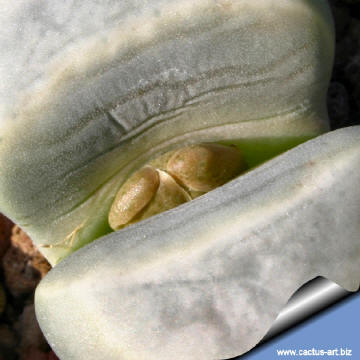 |
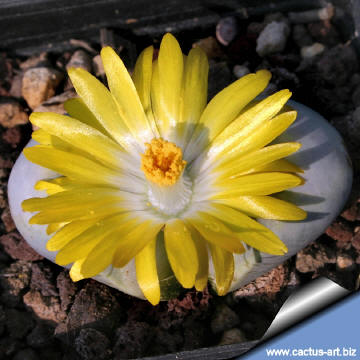 |
|
. |
 |
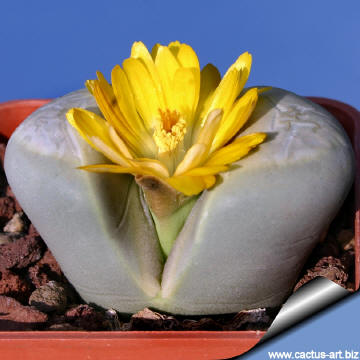 |
|
Advertising
|
|
|
|
|
Family: Mesebrianthemaceae (Aizoaceae)
Scientific name: Lithops
meyeri L. Bolus 1932
Origin: Endemic
to a small area in the Richtersveld, to the north and north-west of
Lekkersing.
TL:
Namaqualand:
Richtersveld, Brakfontein'
Habitat:
Grow in among
small quartzite stones. Colours of the background white, with some
yellow-brown, brown and black. it is a
quartz lover and will always be found growing either on big outcrops
of quartz or more commonly on quartz plains where the quartz pebbles
protect the plants from the blazing summer sun by reflecting a lot of
the light and heat. It closely resembles the white quartz crystalline
rubble of its
habitat. In times of
drought the plants shrivel and are almost invisible, as they get
covered with fine wind-blown
sand. After
rain, however, they
absorb water and become fat and
turgid.
Etymology: Named
after Pastor G.
Meyer who collected this plant in January 1930.
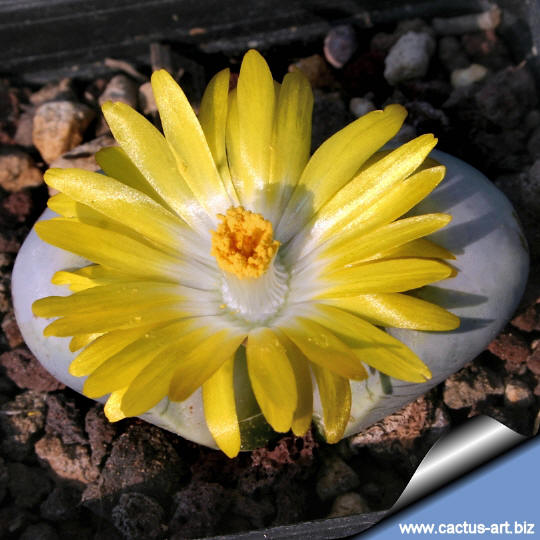
|
|
|
|
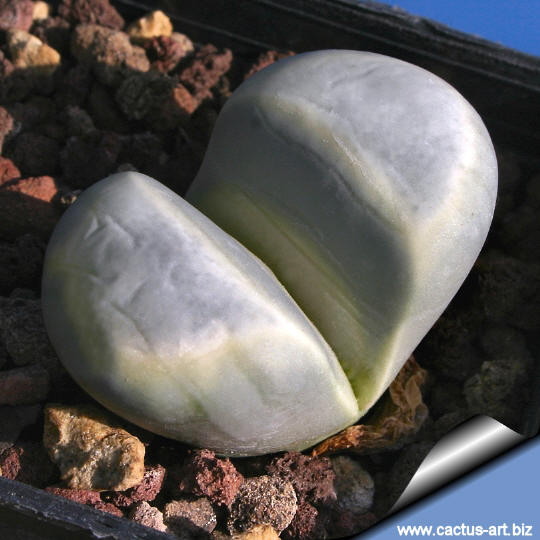
Cultivation: Need an open mineral, fast
draining mix and the maximum amount of light you are able to give them.
The basic cultivation routine is: Stop watering after flowering. Start
watering after the old leaves completely dry. (Usually late March or
Early April) Water freely during the growing season, soak the compost
fully but allow it to dry out between waterings,
no water when cold. Some growers fertilize
frequently, some hardly ever. Keep them dry during the winter. Nearly
all problems occur as a result of
overwatering and poor ventilation especially when weather
conditions are dull and cool or very humid.
This plant is best for a well lit area (Bright
shade to
full sun).
Note: After flowering in the
autumn and extending through
winter
season the plant doesn’t need
watering, but they will still be
growing, the new
bodies will be increasing in size extracting
water from the outer
succulent leaves, allowing them to
shrivel away. In fact the plant in this time extracts
water and
nutrient stored in the outer
succulent leaves, allowing them to
dehydrate relocating the water to the rest of the plant and to
the new leaves that form during this period until the old leaves are
reduced to nothing more than "thin papery shell".


|
|